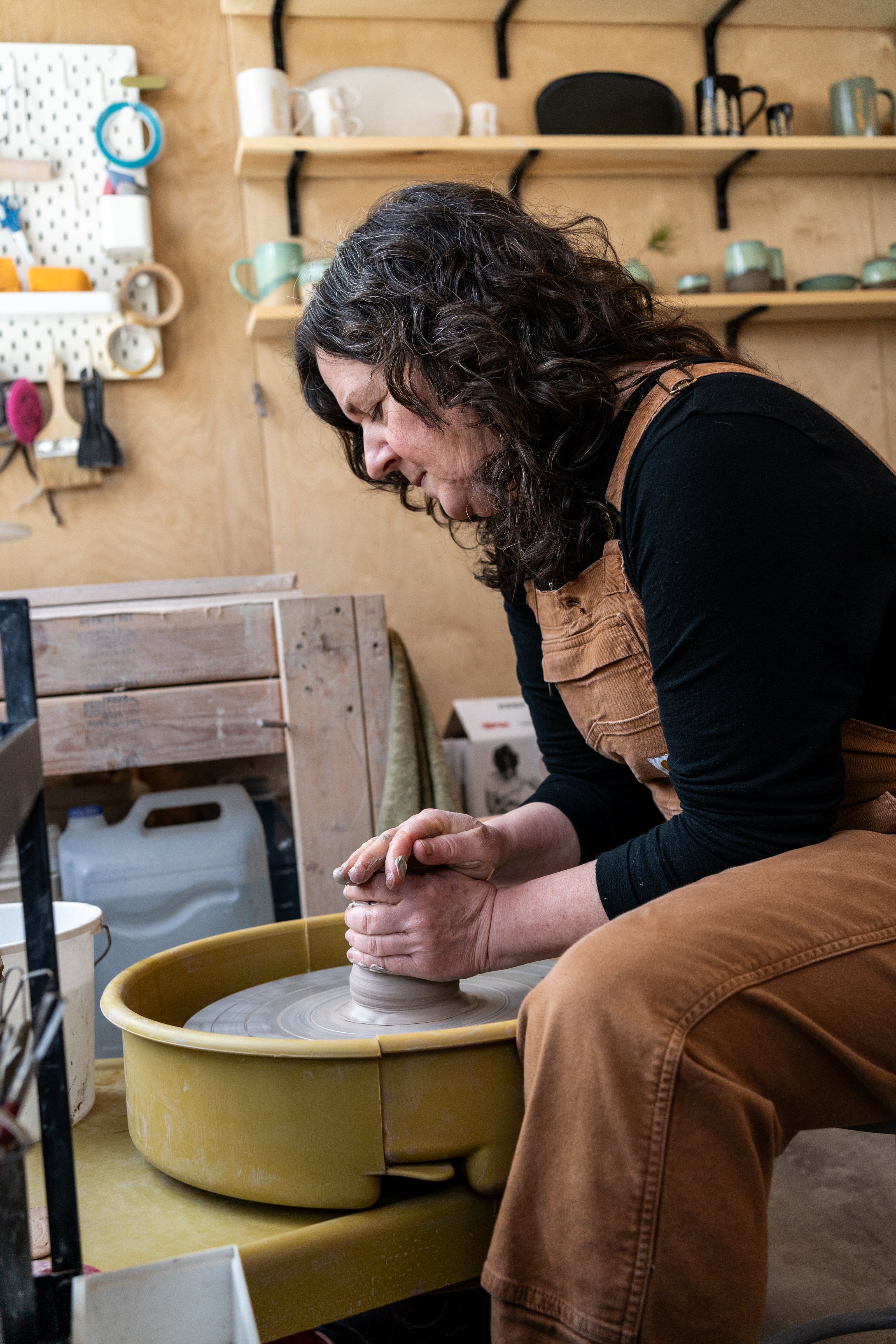
Creative Chemistry – Owl Light Ceramics
Article by Bronwyn Boyer/Photography by Josianne Masseau
Sue Hlywka named her pottery studio Owl Light Ceramics in honour of the moody colours of twilight and her love of owls. “Owlight” or “owl’s light” is a literary term first used in the 1500s to describe the darkening light of dusk, when the owls would become active.
Having her own studio nestled in the wilds of Muskoka is a dream come true for Hlywka and she’s still pinching herself. After growing up at a campground her father built on Kukagami Lake in Sudbury, Ontario, the wilderness feels like home.
“The camp is about 20 miles from the highway and, back then, there wasn’t even a road,” Hlywka recalls. “In the wintertime, we would get there by snowmobile. My dad would tuck us into a little sled he built for it. We had no electricity or running water, just propane and a pump to get water from the lake. It was really awesome in the summers and it’s where my love of nature and the outdoors came from.”
Hlywka’s fascination with the natural world inspired her to study wildlife biology at university. From there, she worked for a non-profit organization called Scientists in School, which operates across Canada teaching workshops in science, engineering and technology, with a focus on environmental stewardship. When she got married, she moved to the United States, where her husband attended grad school. They moved to Guelph for a period of time and then back to the U.S., bouncing between Minneapolis and Chicago. Hlywka worked for the U.S. Forest Service for a while, then did volunteer work teaching English as a Second Language to adult immigrants.
As rewarding as she found that work, Hlywka craved a creative outlet. “I’ve always wanted to try pottery,” she shares. “My son had done pottery in high school when we lived in Minneapolis and he was bringing home these beautiful pieces and it made me really want to try it myself.”
When she moved back to Chicago, Hlywka enrolled in classes at a studio called The Pot Shop, where she was instructed by Dominic Mosca. “I just fell in love with the process,” she recalls. “I loved the feel of the clay and how it can be shaped into whatever you want it to be and the creative component of that. And I liked the practical component too – the self-sufficiency of making pieces that can be used every day.”
Although ceramic arts are a common “hobby” type craft offered by schools and community workshops, it’s a skill that requires a lot of commitment and discipline.
“I didn't realize it would be as challenging as it was,” says Hlywka. “It took me a year to get consistent with centring the clay on the wheel. It was quite a while before I started making pieces. And I’m amazed at how different those pieces are from what I’m making now – it takes a lot of practice.”
Moving to Huntsville in 2020 meant Hlywka was cut adrift, as the closest potter’s guild is in North Bay. “When I belonged to Dominic’s studio, I paid a studio fee and could use his glazes and films and he would do all the firing,” she explains. “Since we moved to Huntsville, I’ve had to teach myself to mix glazes. I had a wheel, but I’d never fired anything myself. My husband and I built a little shed on our property so I’d have a studio and I took online courses in mixing glazes. It’s still a work in progress but I enjoyed learning about the chemical formulations of mixing glazes. I feel so lucky that I can do it all on my own now.”
Hlywka is also grateful for her study in wildlife biology, which gave her the foundation for understanding glazes. “While I loved the biology side of it,” she says. “I didn't love the chemistry and the physics part. But it proved useful all these years later learning to mix glazes.”
And after living in cities for so long, Hlywka and her husband were ready to get back to the woods. Muskoka was already familiar from visiting relatives in Huntsville and its proximity to Toronto was an advantage when Hlywka’s husband has to travel for his job as a food toxicologist. Their move couldn’t have been timed better, as they had just settled in when the COVID-19 pandemic hit.
“I had always dreamed of having a pottery studio in the woods,” says Hlywka. “It just so happened that the dream got fast-tracked because the isolation forced me to make pottery full time. So, here I am, living my dream.”
As an observer and an introvert, being immersed in nature and honouring her creative spirit is the life Hlywka was destined for. She thinks of herself as a potter more than a ceramics artist because of the functionality of her work. And she credits nature for the artistic aspect of her designs, because it’s her biggest inspiration.
“As a child, my dad was always creating things,” she recalls. “He'd find a growth on a tree and make something out of it, like a planter or a bookend. He was always making things that were creative and functional, so that must be where I got it from.”
Hlywka gets design ideas everywhere she looks when she’s immersed in the wilderness. The imprint from a fern frond can look like a tree, and countless designs can be made from pine needles. She also makes what she calls “rock bowls,” which are bowls shaped from rocks she’s collected.
“There are so many great shapes rocks can make,” she explains. “And they have so many varieties of colour in them. I have been formulating my glazes actually to try and mimic them. I have a glaze that I call ‘lichen’ because it reminds me of lichen. I also have one I call ‘the aurora glaze’ created from overlapping colours, that looks like the aurora borealis.”
Hlywka is very intentional when it comes to her craft. She’s not a fast “production potter” that can produce a high quantity of pieces at a time. While she’s in awe of those potters, her studio is small and geared towards perfecting a smaller quantity. If she spends all day working, she can produce about 20 pieces. Part of what slows her down is she carefully weighs her clay and meticulously perfects the art of glaze mixing.
After the pieces are formed, they have to dry for a couple days, then they’re trimmed, and that’s when handles and extra pieces go on. Then they’re fired again, then glazed, then fired again. Overall, it takes her a minimum of three weeks to produce the finished product.
While Hlywka enjoys the artful and scientific process of creating her pieces, she finds the business aspect challenging. “I struggle figuring out what to charge because that aspect of it is not my M.O. at all,” she shares. “But I love that it connects me with people in the community and people who buy my pieces. I love the thought that someone is enjoying something that I created. That satisfying human connection is how I define success.”
Making glazes is perhaps the most exciting part of the process for Hlywka. “It’s like Christmas morning when it’s time to see how it turned out,” she says. “Sometimes it doesn’t turn out anything like I expected, which is always interesting.”
Hlywka tries her glazes on a variety of clay “test bodies” to see how they’ll look. If she runs low on a glaze, she needs to formulate it carefully before making a full new batch.
“It takes some trial and error,” she says. “Some of them don't work very well with certain clays, so it takes a while to get one that works and then be able to reproduce it. Consistency is really important to me. Working with the clay is the creative right-brain part and the glaze is the analytical left-brain part and I love having that balance.”
Pottery is certainly about balance for Hlywka. “It's actually quite therapeutic for me,” she shares. “That’s why I like to go at my own pace. It’s a creative outlet and a meditation at the same time. I retreat into my studio, put music on, or just listen to the birds. It feeds my soul.”
Locally, Hlywka’s finished pieces can be found at Cole’s Art Market or Muskoka Tea Company in Huntsville, Algonquin Art Centre in Algonquin Park and Kala House of Colour in Bracebridge. Her studio in the woods is a place for peace and creative chemistry.
